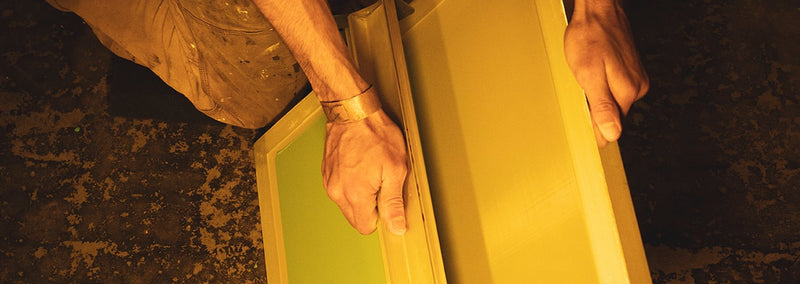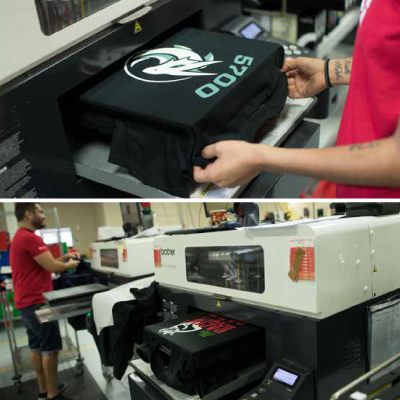Little Known Questions About Tx Tees.
Little Known Questions About Tx Tees.
Blog Article
The Facts About Tx Tees Uncovered
Table of ContentsA Biased View of Tx TeesFascination About Tx TeesThe Only Guide to Tx TeesThe smart Trick of Tx Tees That Nobody is Talking AboutThe Basic Principles Of Tx Tees The Only Guide to Tx TeesFascination About Tx Tees
Include up various other expenses, like the number of utilities it takes to run the store and the price of ink and emulsion per layout. Take the print below.The emulsion needs to just be a couple of cents because you 'd only need to coat one display for this job. So just how much should you bill per tee shirt to make a profit? Normally, printers attempt to make up to 45% earnings on a print job. Right here's a table to assist you establish that: complete cost per item percent of preferred revenue as a decimal (example:.25 or.45) earnings made per thing per work Currently let's discuss the earnings of DTF.

With DTF, you can print a handful of t shirts, or just one. Both screen printing and DTF have their specific niches in the globe.
The Best Guide To Tx Tees
The very best way to understand? Ask about and see what print stores like your own are doing. embroidery shop. Attempt both out and see which you like better
When you're choosing what type of printing technique to make use of for publishing your art work designs on your garments, it's crucial that you recognize the differences in between these 2 strategies so you can make the most of outcomes while decreasing costs. Screen printing is the most typically utilized method for printing styles on textiles.
DTG printing is likewise called place or direct to garment printing because it prints only what is required rather than making a display as display printers do. https://filesharingtalk.com/members/594250-txtees02?tab=aboutme&simple=1. Screen printing works by screen filler squeegee display printing ink screen mesh display, then moving the picture to garment using warm and/or pressure
The DTG printer utilizes special dye-sublimation inks that are applied right into a pre-designed picture by a digital printing system. The inks enter into the textile, enabling for vivid colors and exceptional information. It's also called place or direct to garment printing due to the fact that it prints only what is required rather than making a screen as display printers do.
The Ultimate Guide To Tx Tees
First, it's much faster - you can print a fullcolor picture in mins, in contrast to hours for display printing. Second, there's no established up time or prices involved - you can publish any design you like, without having to create a screen. Third, there's no waste - because screen printers screen print one style each time, they need to evaluate each shade independently.
The paper is very costly and can just be utilized once. Once it's printed on, it needs to be disposed of. - The first purchase cost is lower than the in advance financial investment of DTG printers- You can print multi-color layouts one display each time rather than needing to publish each shade separately like DTG printing.

The Ultimate Guide To Tx Tees
Rather of utilizing display mesh as display printers do, color sublimation printers use laser technology to move your images onto garments or paper. A heat process moves the color from its solid-state straight into the gas phase which consequently integrates it onto material substratums when they are rapidly heated to high temperatures under high stress.
Sublimation printing is environmentally friendly. It makes use of much less water than screenprinting, and due to the fact that it doesn't involve the use of unsafe solvents, it's safe for all types of apparel. The dye sublimation inks are also odor-free when healed, unlike display printers that make use of harmful chemicals throughout the screen printing procedure that leave an undesirable smell.
They likewise conserve cash on expensive devices like direct exposure devices since dye sublimation printers don't call for a UV direct exposure device or a flash treatment stove that is commonly made use of in display printing (t-shirt printing). What is direct to garment printing (DTG Printing)? DTG printing is a digital screenprinting process that publishes straight onto fabric utilizing specialized inkjet printers
The Of Tx Tees
DTG printing provides several advantages over conventional screenprinting, including the capacity to print photographic quality images, better color vibrancy, and the ability to publish designs on darker materials. DTG printers work by warming the textile ink till it develops into a gas. The gas then penetrates the fabric, bonding with the fibers to develop a permanent print.

Display printers just prepare their screen after that start publishing up until they run out of product or ink.- There is a broad range of skilled screen printers all over the globe, which can be handy for newbies. - It's a slower procedure - display printers commonly have to wait for the ink to completely dry prior to they can publish the next shade- Display printers need manual work, so there's a greater learning contour and it takes longer to produce a high-quality layout- Screen printing isn't as exact as DTG printing, so you might obtain some "bleeding" of colors from one component of the image onto another otherwise done effectively.
Tx Tees Can Be Fun For Anyone
However, rather of using display mesh as screen printers do, color sublimation printers use laser modern technology to transfer your pictures onto garments or paper. A heat process moves the dye from its solid-state straight right into the gas phase which subsequently fuses it onto material substratums when they are rapidly heated up to high temperature levels under high pressure.
Sublimation printing is environmentally friendly. It makes use of much less water than screenprinting, and because it does not entail using dangerous solvents, it's secure for all kinds of clothing. The color sublimation inks are additionally odor free when treated, unlike display printers that use hazardous chemicals throughout the display printing procedure that leave an unpleasant odor.
They likewise conserve cash on pricey tools like exposure units because dye sublimation printers do not need a UV direct exposure device or a flash treatment oven that is normally made use of in display printing. What is straight to garment printing (DTG Printing)? DTG printing is an electronic screenprinting procedure that publishes straight onto textile using specialized inkjet printers.
Tx Tees - The Facts
DTG printing offers many advantages over traditional screenprinting, including the capacity to publish photographic quality images, greater shade vibrancy, and the capability to print designs on darker fabrics. DTG printers function by warming the textile ink until it develops into a gas. The gas then permeates the textile, bonding with the fibers to produce a long-term print.
Report this page